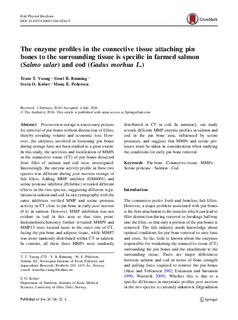| dc.description.abstract | Post mortem storage is a necessary process for removal of pin bones without destruction of fillets, thereby avoiding volume and economic loss. However, the enzymes involved in loosening pin bones during storage have not been studied to a great extent. In this study, the activities and localization of MMPs in the connective tissue (CT) of pin bones dissected from fillet of salmon and cod were investigated. Interestingly, the enzyme activity profile in these two species was different during post mortem storage of fish fillets. Adding MMP inhibitor (GM6001) and serine protease inhibitor (Pefabloc) revealed different effects in the two species, suggesting different regulations in salmon and cod. In situ zymography with the same inhibitors verified MMP and serine protease activity in CT close to pin bone at early post mortem (6 h) in salmon. However, MMP inhibition was not evident in cod in this area at that time point. Immunohistochemistry further revealed MMP9 and MMP13 were located more to the outer rim of CT, facing the pin bone and adipose tissue, while MMP7 was more randomly distributed within CT in salmon. In contrast, all these three MMPs were randomly distributed in CT in cod. In summary, our study reveals different MMP enzyme profiles in salmon and cod in the pin bone area, influenced by serine proteases, and suggests that MMPs and serine proteases must be taken in consideration when studying the conditions for early pin bone removal. | |
